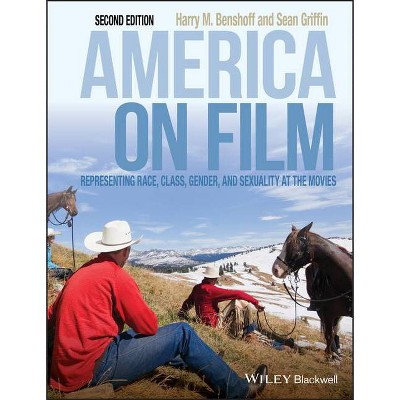America on Film 2e - by Benshoff (Paperback)

Product info
<p/><br></br><p><b> Book Synopsis </b></p></br></br><i>America on Film: Representing Race, Class, Gender, and Sexuality in the Movies, 2nd Edition</i> is a lively introduction to issues of diversity as represented within the American cinema. <br /> <ul> <li>Provides a comprehensive overview of the industrial, socio-cultural, and aesthetic factors that contribute to cinematic representations of race, class, gender, and sexuality</li> <li>Includes over 100 illustrations, glossary of key terms, questions for discussion, and lists for further reading/viewing</li> <li>Includes new case studies of a number of films, including <i>Crash, Brokeback Mountain, </i> and <i>Quinceañera</i></li> </ul><p/><br></br><p><b> From the Back Cover </b></p></br></br><p><i>"America on Film</i> is different kind of film studies textbook. It's an invaluable resource for classes examining the politics of Hollywood."</br> <b>Ted Friedman, <i>Georgia State University</i></b> <p>"The authors do a remarkable job at presenting contexts for identifying and tracking the historical constructions of race, gender, class, and sexuality ... They successfully present a rich history, with references to hundreds of films."</br> <b><i>Scope Journal</i></b> <p><i>"America on Film</i> provides a clear and expansive examination of the complexities of representation and identity in America cinema. I currently use Benshoff and Griffin's book in my introductory film class on multiculturalism, and I look forward to using this new edition."</br> <b>Vici Callahan, </b> <b><i>University of Wisconsin-Milwaukee</i></b> <p>"In this era of diversity, <i>American on Film</i> is a great resource that clarifies critical concepts of inequality and illustrates how film representations can frame groups, thus providing tools for thinking critically about the media we consume."</br> <b>Elizabeth Higginbotham, </b> <b><i>University of Delawarwe</i></b> <p><i>"America on Film</i> does what no other film textbook does: it takes its investigations of film beyond a study of form, production and exhibition, exposing how film functions as a powerful cultural agent for shaping American perceptions of race, gender, class, and ability."</br> <b>Alison Landsberg, </b> <b><i>Georgia Mason University</i></b> <p><b><i>America on Film: Representing Race, Class, Gender, and Sexuality at the Movies</i></b> is a lively introduction to issues of diversity as represented within the American cinema. The first synthetic and historical text of its kind, <i>America on Film</i> provides a comprehensive overview of the industrial, socio-cultural, and aesthetic factors that contribute to cinematic representations of race, class, gender, and sexuality. The volume chronicles the cinematic history of various cultural groups, examines forces and institutions of bias, and stimulates discussion about the relationship between film and American national culture. <p>The book is organized within a broad historical framework, with specific theoretical concepts - including film genre, auteurism, cultural studies, Orientalism, the "male gaze," feminism, and queer theory - integrated throughout. Each individual chapter features a concise overview of the topic at hand, a discussion of representative films, figures, and movements, and an in-depth analysis of a single film, including <i>The Lion King, The Jazz Singer, Smoke Signals, The Grapes of Wrath, </i> and <i>The Celluloid Closet.</i> <p>This new edition is fully revised and updated. It includes a new chapter on the representation of disability in American film, and a new collection of updated case studies, including discussions of <i>Erin Brockovich, 8 Mile, Crash, </i> and <i>Brokeback Mountain, </i> among others.<p/><br></br><p><b> Review Quotes </b></p></br></br><br>Concluding each chapter are discussion questions and lists of further reading and relevant films. Particularly valuable are the 28 two-page case studies (e.g., of <i>Lion King</i>, <i>Jazz Singer</i>, <i>Grapes of Wrath</i>, <i>Gilda</i>, <i>Celluloid Closet</i>, <i>Crash</i>, <i>Brokeback Mountain</i>) scattered throughout. These analyze the films in terms of culture group. A model of sociological criticism and an invaluable tool (in classroom or library) for film students. (<i>CHOICE</i>, August 2009)<br /> <br /> <i>America on Film</i> is a different kind of film studies textbook. It's an invaluable resource for classes examining the politics of Hollywood. <i>Ted Friedman, Associate Professor of Moving Image Studies, Georgia State University</i><br /> <p>"The authors do a remarkable job at presenting contexts for identifying and tracking the historical constructions of race, gender, class and sexuality ... They successfully present a rich history, with references to hundreds of films." <i>Scope Journal</i></p> <p><i>America on Film</i> provides a clear and expansive examination of the complexities of representation and identity in American cinema. I currently use Benshoff and Griffin's book in my introductory film class on multiculturalism, and I look forward to using this new edition. <i>Vicki Callahan, University of Wisconsin-Milwaukee</i></p> <p>In this era of diversity, <i>American on Film</i> is a great resource that clarifies critical concepts of inequality and illustrates how film representations can frame groups thus providing tools for thinking critically about the media we consume. <i>Elizabeth Higginbotham, University of Delaware</i></p> <p><i>America on Film</i> does what no other film textbook does: it takes its investigation of film beyond a study of form, production and exhibition, exposing how film functions as a powerful cultural agent for shaping American perceptions of race, gender, class and ability. <i>Alison Landsberg, George Mason University</i></p><br><p/><br></br><p><b> About the Author </b></p></br></br><p><b>Harry M. Benshoff</b> is Associate Professor of Radio, Television, and Film at the University of North Texas. <p><b>Sean Griffin</b> is Associate Professor of Cinema and Television at Southern Methodist University.
Price History
Price Archive shows prices from various stores, lets you see history and find the cheapest. There is no actual sale on the website. For all support, inquiry and suggestion messagescommunication@pricearchive.us